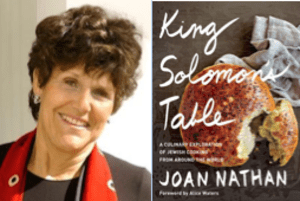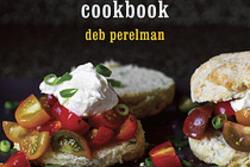Joan Nathan on Food, Travel, and Tradition
At the Jewish Women’s Archive we believe that good food and good stories will always bring us together. When both the food and the stories are provided by a culinary Jewish superstar like Joan Nathan, forming these kinds of connections is easy. From tarts to tagines, from lox to latkes, Joan’s recipes have brought families together for decades. JWA’s food writer, Lisa Yelsey, sat down with Joan to discuss her upcoming book King Solomon’s Table, how her travels shape her writing, and if gefilte fish and borscht will ever make it in mainstream America. Following is their conversation, which demonstrates that a young food writer at the beginning of her career and a well-established pioneer find common ground and lots to discuss when Jewish food is the topic!
Lisa Yelsey: How do you relate Jewish Food to family and culture? How did you first get into Jewish cooking?
Joan Nathan: Well, first of all, I think I learned how to cook in Home Ec Class in Larchmont, New York, when I was in 6th or 7th grade. But you always had to cook growing up. I didn’t really learn from my mother at first, though I loved the plum pie she would make for Rosh and it was really delicious... I just remember her placing the plums in the pie.
I would watch my father’s sister, who was German (my mother was American-born), make cookies and other things. So I got this interest in other cuisines from my father. And then when I got married, my mother-in-law was a really good Polish cook, and more importantly, she had one of these MFK Fischer memories and would talk about life and food in Poland.
So for me, food was always cultural and that’s the way I’ve always approached it. Before I became a food writer, I wanted to be a sociologist or anthropologist. And in a way that’s what I’ve done.
When you write about a recipe, does it make you think differently about the food?
Oh, yeah. I think about all the components of it, and I think about where it came from and from what point in history. I was trained to think analytically at my classical high school in Providence, and I also studied in France for a year, which made me much more analytical about food than most people.
I never thought about this before but I think it’s true: I often will dissect a meal. I like to know where a chef or cook is coming from, and what the components are, and why they’re there. But I’m more interested in the sociological or anthropological aspects of it than I am in the specific technique.
On your recent travels, is there anything that has surprised you?
Surprises? There’s always a surprise! Like I was in El Salvador, and there are about a hundred Jews in El Salvador, and they made a Shabbat dinner for me. On the table, I saw recipes like chocolate salami, which hasn’t really changed from Europe. And then somebody made yucca pancakes with a cilantro cream, which is something different and probably what more of us would probably like to eat.
Jewish adaptations like the yucca pancake no longer surprise me. That’s what Jewish food is: adapting to new circumstances and cuisines while retaining our connection to tradition, dietary laws, and holidays.
Could you speak a little bit more about that?
Well, I think that there are three components of Jewish food. One is the dietary laws. There are so many different kinds of Jews, and I really believe there were always so many different kinds of Jews. The second component of Jewish food comes from the mercantiles: the Jewish merchant. The Jews have always been going after the unknown in the food world since the time of King Solomon. The Jews went as far as India looking for Jewish food for the temple of Jerusalem, and there were also the Jewish bakers. To this day, there is a Jewish obsessiveness about food. And then the third component to me is the adaptation. Jews have been kicked out of countries, and have had to adapt to new surroundings and new ingredients but always with the dietary laws in their mind.
In a sense, the whole idea of the Sabbath and the holidays and the whole idea of what it means to be a Jew has held them together throughout the years.
When writing about traditional foods, how do you keep ideas and recipes fresh?
Well, you know we all change. We’re always changing. And Alice Waters was telling me about a persimmon pudding recipe she makes that she loves. We were having dinner together, and I said to her, where did you get the recipe? And she said oh, it’s in all of my books. She said we love this recipe and we’re constantly making it better, and I thought, of course, that’s what we all do. I mean not all of us, but I certainly am. Going to different countries and learning different things keeps old recipes fresh.
I’ve also had fun learning about new versions of traditional recipes I’ve never heard of from people that I’ve met on the book tour. I’m doing a little bit of research to find those recipes. I have a very big library, so I start there, and I know historians and other people so it’s fun.
As you update these recipes are there any trends you are noticing in food?
I think a lot of Jewish food is very tired and never want my food to get tired. So you know, people give me new ideas, and I play around with them, but I don’t want my food to be gimmicky. I never want to do that. I think that we’re all too busy to spend a lot of time with gimmicky food. I really want to preserve what’s already good.
Have you seen a shift in attitude or perception of Jewish food during your career?
Oh, for sure. When I first started writing, Jewish food wasn’t of much interest to people. It was, in a way, disdained. And now, lots of people love Jewish food––it’s respected. Even if politically if they don’t like Jewish food, they’ll use it. Food is above politics today, really.
And it’s even trendy. Many restaurant owners reach out to me because they want to know how Jewish chefs are doing Israeli food or Jewish diaspora food so it can feel authentic. It’s a fascinating shift.
Is there a Jewish food that you wish were more popular or mainstream in America?
Well, I like gefilte fish. I wish not that it were more mainstream––because it never will be mainstream with a name like gefilte fish!––but I would like it if my kids didn’t disdain it the way they do. To this day I would say none of them like it, but at least they like the horseradish that goes with it. Gefilte fish has a very bad reputation, and I think it stems from Julia Child––she never liked it. She would be polite, but she never liked it.
It is probably one of the most divisive Jewish foods.
One of the most maligned foods! Another one is borscht, I think. First of all, there’s tons of borscht. It’s not just the sweet borscht people know about. But there are tons of delicious borscht recipes; there’s a delicious one in my new book.
What’s coming up next for you?
I’ve been doing a lot of speaking around the country right now for this book, which gives me a chance to see places. I’d like more and more of that. I want to travel and see the world and spend time with my family, but I think I will be doing another book because it’s exciting. My next book is going to be an update of a lot of foods that you know, how I make them now and new recipes. I’m going to Germany to find out a little bit more about my family history. You know, I have no big plans for the future. I like doing what I'm doing. It’s been fun, it’s been a great ride.
Joan Nathan’s newest cookbook, King Solomon’s Table, is available now!
To join Lisa in her adventures as she navigates tradition and television while cooking Jewishly, visit her author page!








Hi Joan, Among your many other honors, congratulations on being immortalized in the Jewish Womens Archives, located in Brooklline.